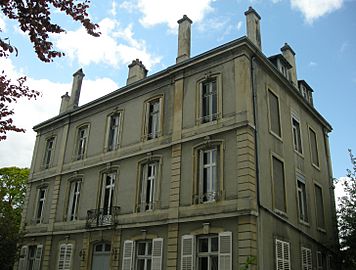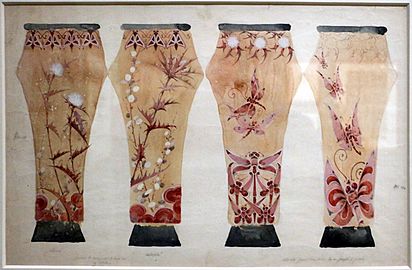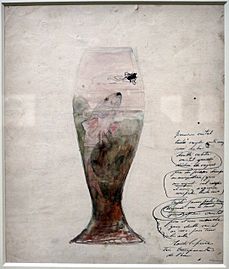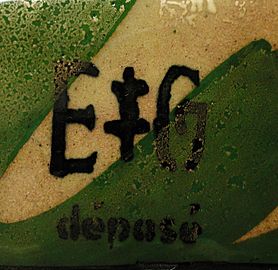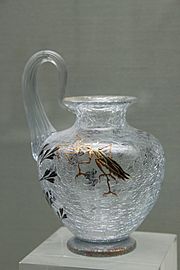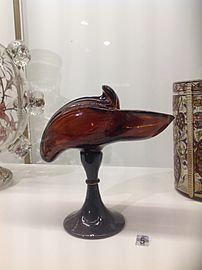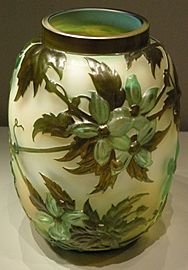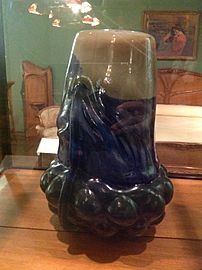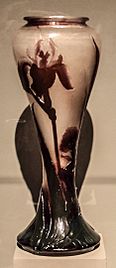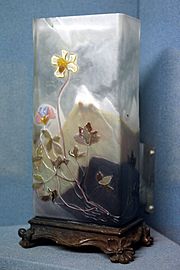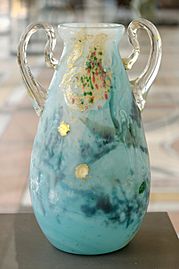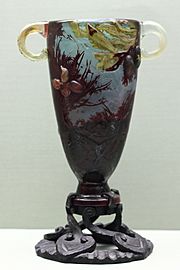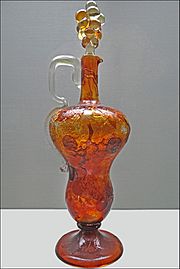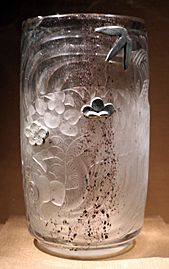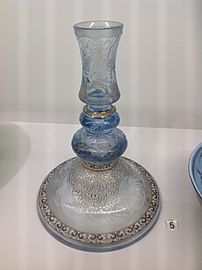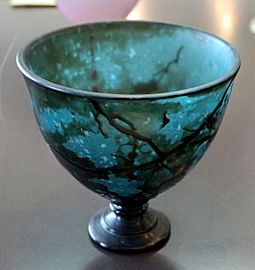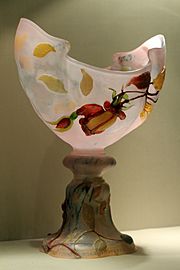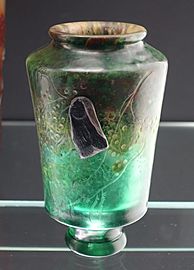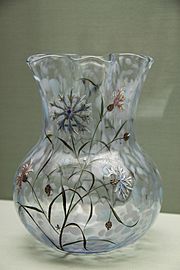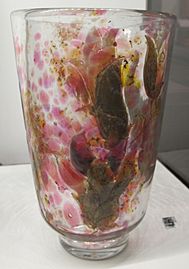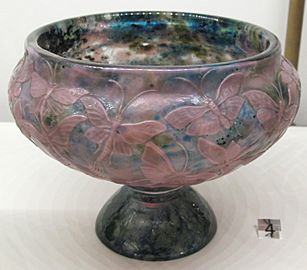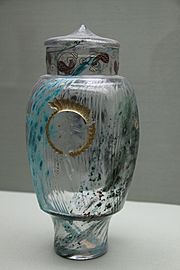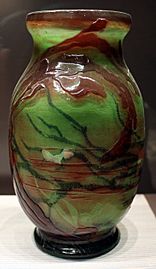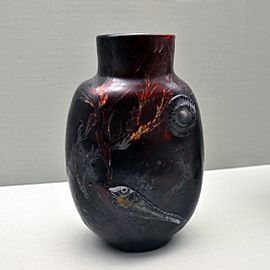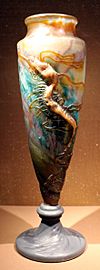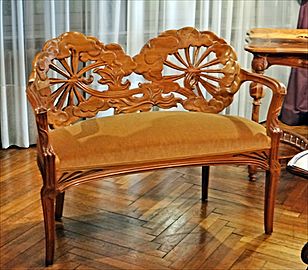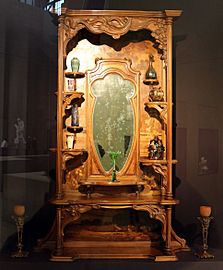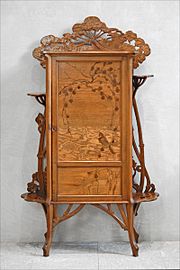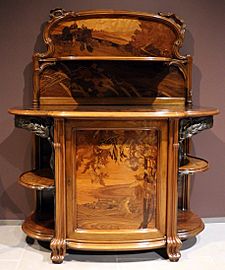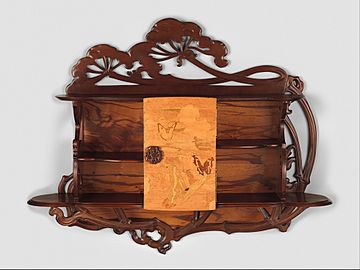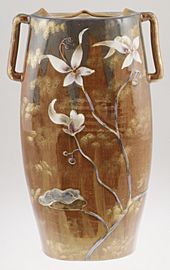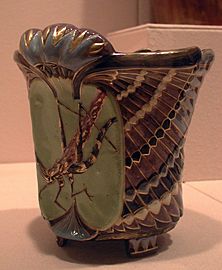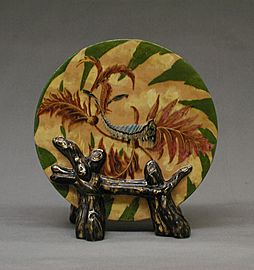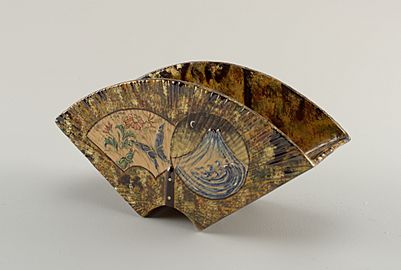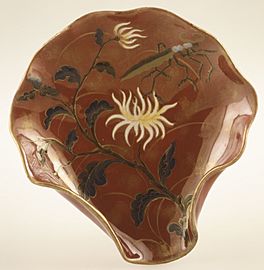Émile Gallé facts for kids
Quick facts for kids
Émile Gallé
|
|
|---|---|
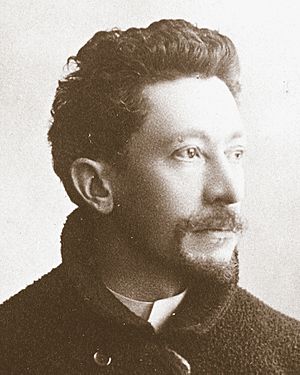
Émile Gallé, (1889) Photo for entry card to 1889 Paris Exposition
|
|
| Born | 8 May 1846 Nancy, France
|
| Died | 23 September 1904 (aged 58) Nancy, France
|
| Occupation | Glass artist |
Émile Gallé (born May 8, 1846, died September 23, 1904) was a famous French artist and designer. He was known for his beautiful work with glass and Art Nouveau furniture. Gallé was a key figure in the Art Nouveau movement in France. He also helped start the École de Nancy, a group of artists and designers in his hometown of Nancy, France.
Contents
Biography
Early Life and Education
Émile Gallé was born in Nancy, France. His father, Charles Gallé, sold glassware and ceramics. His mother's family owned a mirror factory. Émile's father took over the family business. He started making glassware with flower designs.
Young Émile studied philosophy and science in Nancy. At 16, he began working for his family's business. He helped create flower designs for both ceramics and glass. In his free time, he became a skilled botanist. He studied plants with D.A. Godron, who was the director of the Botanical Gardens of Nancy. Émile collected plants from many places, including Italy and Switzerland. He also took art classes and drew many pictures of plants, flowers, animals, and insects. These drawings later became designs for his art.
From 1862 to 1866, Émile studied in Weimar, Germany. He continued learning about philosophy, botany, sculpture, and drawing. In 1866, he became an apprentice at a glass factory in Meisenthal. He learned a lot about the chemistry of making glass. Some of his early glass and ceramic pieces were shown at the 1867 Paris Universal Exposition. In 1870, he designed a set of dishes with animal themes. During this time, he met Victor Prouvé, an artist who later worked with him in the Nancy School.
Émile served in the army during the Franco-Prussian War in 1870. After the war, France lost some land to Germany, including Meisenthal. Because of this, the Cross of Lorraine, a symbol of his home region, became part of his signature on many artworks.
After the war, Gallé traveled to London and Paris. He visited museums and studied ancient art, especially Islamic glass. This inspired his later work. He also traveled to Switzerland and Italy. When he returned to Nancy, he set up his own workshop at the family glass factory. His father was still in charge, but Émile slowly took over the design and production. In 1873, he moved into "La Garenne," a large house with beautiful gardens built by his father.
Leading the Company to Success
In 1874, Émile's father gave him full control of the family business, Maison Gallé-Reinemer. The next year, Émile married Henriette Grimm and settled in Nancy. He reorganized the glass and ceramic parts of the business. In 1883, he built new, larger workshops for glass, ceramics, and furniture. By 1889, he had over 300 employees. His own office was in the middle of the workshops.
He personally trained his designers. He sent them watercolor drawings of flowers from his gardens. Gallé told his designers to always use real flowers and plants as their models. He believed that art should be inspired by nature.
Gallé's business grew even more. In 1885, he opened his first shop in Paris. He later opened more shops in Frankfurt-am-Maine and London. He also showed his art at big international exhibitions. These included the 1878 Paris Universal Exposition and the 1893 World's Columbian Exposition in Chicago. The most important was the 1900 Paris Universal Exposition. Here, he won two Grand Prizes, a gold medal, and was named a commander in the Legion of Honor.
Later Years and Legacy
In 1901, Gallé helped start and became the first president of the École de Nancy. This group encouraged new art styles in Nancy. Other famous artists like Antonin Daum and Louis Majorelle were also part of it. Many important people bought Gallé's works, and museums collected them. Other glass companies even copied his designs, which showed how popular he was.
Much of his later art used symbols and showed deep feelings. For example, on a vase called Fiori Oscuri, he wrote words about light and dark struggling together.
Gallé also cared about social issues. He helped create a university for workers in Nancy. He supported human rights and spoke up for people who were treated unfairly.
In 1904, Émile Gallé became very ill with leukemia. He died on September 23, 1904. His son-in-law took over the company. However, the company did not keep up with new art styles and closed in 1931. Today, only the carved wooden door from his original studio remains. It is now in the garden of the Musée de l'École de Nancy.
Gallé wrote a book about art called Écrits pour l'art 1884-89. It was published after he died in 1908.
Glassware
Émile Gallé was a master of glass art. He used many different techniques to create his unique pieces.
Glass Techniques and Innovations
Gallé often used two techniques called cased glass and cameo glass.
- Cased glass involves layering different colors of glass. First, one layer of glass is made and cooled. Then, a second layer is blown inside the first. The piece is heated again so the layers melt together. This process can be repeated for many layers.
- Cameo glass is a way to decorate cased glass. Once the cased glass has two or more colors, designs are carved into it. This can be done with a diamond saw or acid. The carving removes the top layer, showing the different colors underneath to create a picture.
- Enamel glass was decorated on the outside. Artists used brushes to paint designs with special enamels that got their colors from metals.
Gallé was always trying new ways to work with glass. One of his big ideas was glass marquetry. This means adding layers of colored glass onto a hot glass object. He could join these layers or overlap them, creating many colors and textures. This technique was used before by artists in Venice, but Gallé made it much more advanced. It allowed him to make endless designs, but it was also tricky. The glass had to be reheated for each new layer, and it could easily crack.
He also found a way to use small flaws in the glass, like bubbles or dust. He called this "patina." Instead of hiding these imperfections, he used them as part of the design. He would dust the hot glass surface to make it look like fabric or a spiderweb. He could then engrave, sandblast, or carve the surface. Sometimes, he would even embed small pieces of hot glass into this outer layer. The finished piece would then be covered with a thin layer of clear glass.
-
Glass cup in form of Lamiaceae flower, of blown and molded glass (1889)
Vibrant Colors in Glass
Gallé was very creative in making and using colored glass. In 1878, he made a soft sapphire blue by adding a tiny bit of cobalt oxide. He called this color "Clair de lune," meaning "moonlight." Other glassmakers copied this color.
He also created many other colors. He made yellows, iridescent browns, and greens using silver and sulfur. He got a peacock blue from copper and iron. He even used rare metals like thallium and iridium for very dark shades. His most special colors were a deep violet from manganese, a pink from selenium or copper (made in 1889), and a green from chromium. This green was often used in pieces with three or four layers, giving them amazing depth.
His style focused on nature and flower designs. This was a key part of the new Art Nouveau movement.
Gallé's early work used clear glass with enamel decorations. But he soon developed his own style. He used heavy, opaque glass that was carved or etched with plant designs. Often, these pieces had two or more colors, like cameo glass.
He kept trying new things, like adding metallic foils and air bubbles to his glass. He also helped the glass industry by setting up a workshop to make many copies of his and other artists' designs.
Flowers in Glass Art
Many of Gallé's glass pieces, especially vases, were inspired by and named after flowers. He loved botany and had a large flower garden at his home. He used these real flowers as models for his art. He also made his artists use actual plants when they were drawing designs.
Flowers had a special meaning for Gallé. He believed that each flower and fruit had a symbolic message. For example, the olive leaf meant peace, and wheat meant kindness. The grape symbolized the Eucharist, and the fig meant generosity. The Veronica flower stood for loyalty, and the myrtle for joy. The narcissus represented springtime.
Insects and Undersea Worlds
Nature was always a big part of Gallé's art. Flowers, plants, insects, and sea creatures were common subjects. He made vases that looked like they were full of fish and other animals. Other pieces showed forest scenes with colorful dragonflies and other insects.
Furniture
Gallé became interested in wood in 1885. He was looking for unusual woods to make bases for his glass vases. He was amazed by the many colors and shiny qualities of woods from around the world. Within a year, he started his own furniture workshop. He hired skilled carpenters, sculptors, and experts in marquetry (inlaying different woods). He also hired metalworkers for knobs and locks. Victor Prouvé helped him with designs.
Gallé was willing to use machines to make furniture faster, as long as it didn't lower the quality. He experimented with sculpting locks and heating bronze to get the exact color he wanted. He collected 600 different kinds of wood. This allowed him to create marquetry with the perfect colors, shades, and wood grain. By 1889, he had a very successful display of his furniture at the Paris Universal Exposition.
He wrote an article about his ideas for furniture design. He believed that true beauty came from carefully following the patterns of nature. Every detail and design on his furniture came directly from nature.
Ceramics and Pottery
Gallé's early ceramic pieces were usually plates and vases with traditional flower designs. His faience, which is glazed earthenware, was not as famous as his glass art. He mostly stopped making ceramics after 1892.
However, his ceramics still showed his amazing imagination. His pottery often looked like real earth, using brown colors. He added designs of leaves and insects, making them very unique.
See also
 In Spanish: Émile Gallé para niños
In Spanish: Émile Gallé para niños
- Art Nouveau glass


